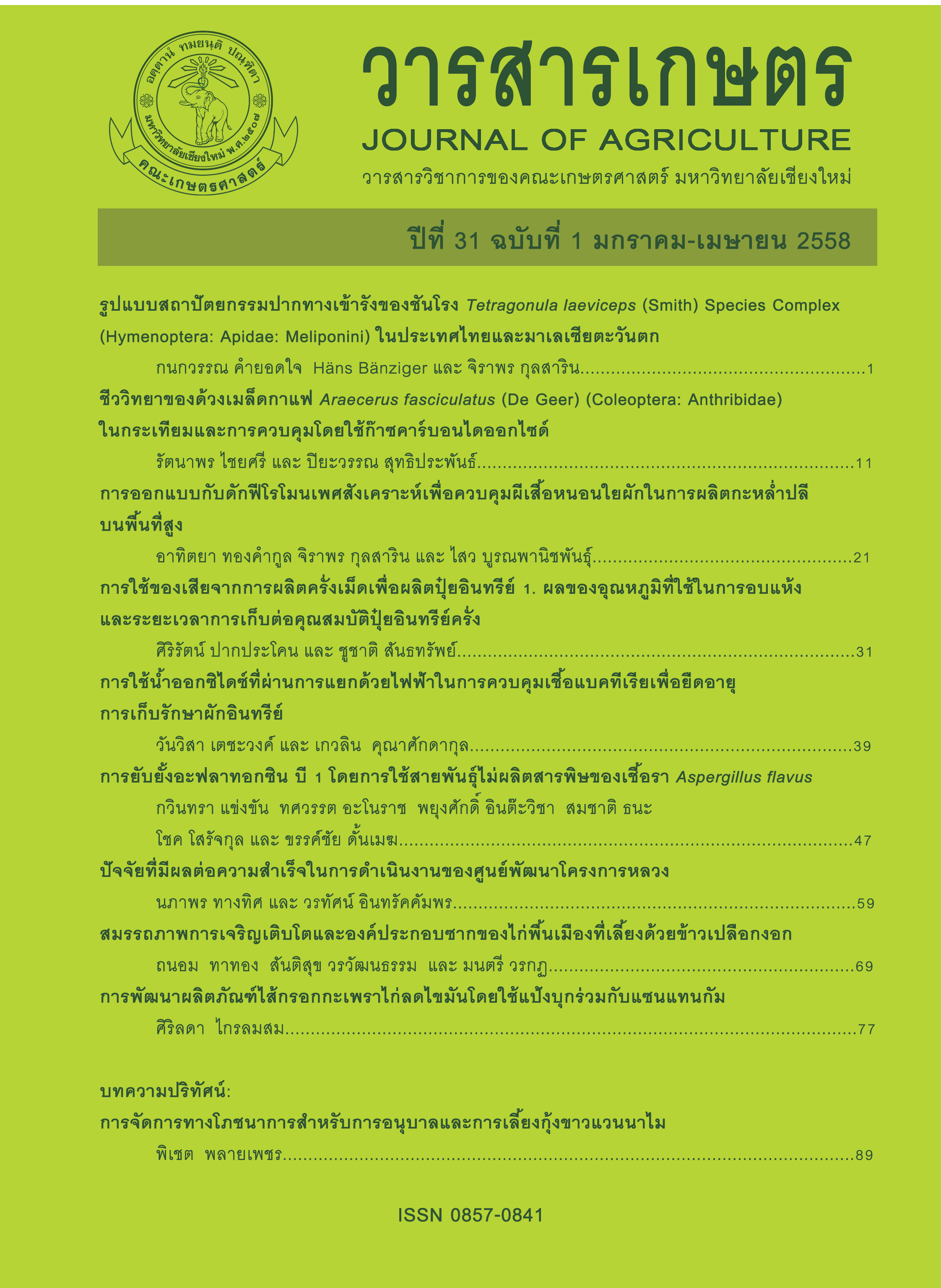การยับยั้งอะฟลาทอกซิน บี 1 โดยการใช้สายพันธุ์ไม่ผลิตสารพิษของเชื้อรา <I> Aspergillus flavus </I>
Main Article Content
บทคัดย่อ
การยับยั้งการผลิตสารพิษอะฟลาทอกซิน บี1 (AFB1) ของเชื้อรา Aspergillus flavus ได้ถูกทดสอบในระดับห้องปฏิบัติการโดยใช้เชื้อรา A. flavus จำนวน 4 สายพันธุ์ ได้แก่ A. flavus UPA01 UPA02 UPA03 และ UPA04 ซึ่งเป็นชนิดเดียวกันแต่เป็นสายพันธุ์ที่ไม่ผลิตสารพิษอะฟลาทอกซิน คัดแยกได้จากดินบริเวณที่ปลูกข้าวโพดเลี้ยงสัตว์ ในจังหวัดพะเยา ประเทศไทย การทดลองเริ่มจากการศึกษาอัตราการเจริญเติบโตของเชื้อราบนอาหารแข็ง (Kr) โดยใช้ Potato Dextrose Agar (PDA) และบ่มเลี้ยงเชื้อราที่อุณหภูมิ 30ºซ ในที่มืด เมื่อเปรียบเทียบระหว่างสายพันธุ์ของเชื้อรา A. flavus ที่ใช้ทดสอบ ผลการทดลองพบว่าค่า Kr ของเชื้อรา A. flavus ไม่มีความแตกต่างกันอย่างมีนัยสำคัญ ค่า Kr เฉลี่ยของเชื้อรา A. flavus มีค่าการเจริญ 0.7 ซม.ต่อวัน ในด้านการศึกษาการผลิตสารพิษอะฟลาทอกซินทำได้โดยนำสปอร์ของเชื้อรา A. flavus ความเข้มข้น 1x105 สปอร์ต่อมล มาบ่มเลี้ยงในอาหารสูตร modified yeasted sucrose (mYES) เป็นเวลา 7 วันที่อุณหภูมิ 30 °ซ ในที่มืด เชื้อรา A. flavus NRRL3357 ซึ่งเป็นสายพันธุ์ที่ผลิตสารพิษอะฟลาทอกซินมีการผลิตสารพิษอะฟลาทอกซิน บี1 คือ 5.361±259.10 นกต่อมล ในขณะที่เชื้อรา A. flavus ทั้ง 4 สายพันธุ์ที่ใช้ทดสอบไม่มีการผลิตอะฟลาทอกซิน (บี1 บี2 จี1 และ จี2) เมื่อนำไปเลี้ยงร่วมกันกับ A. flavus NRRL3357 ที่ผลิตอะฟลาทอกซินในอาหารสูตร modified yeasted glucose (mYEG) พบว่าเชื้อราทั้ง 4 สายพันธุ์นี้สามารถยับยั้งการผลิตสารพิษอะฟลาทอกซิน บี1 ได้มากกว่า 70 เปอร์เซ็นต์ สำหรับการศึกษาการเจริญของเชื้อราจะใช้สมการศึกษาของ Monod ซึ่งพบว่าเชื้อรา A. flavus ที่นำมาทดสอบมีค่าอัตราการเจริญเติบโตจำเพาะ (µ) ที่ใกล้เคียงกัน ในค่าอื่น ๆ เช่น อัตราการใช้สับสเตรทจำเพาะ (qs) เชื้อรา A. flavus NRRL3357 มีค่า qs มากที่สุด (0.22 mmol/g cell/hr) แต่จะลดลงเมื่อมีการเลี้ยงร่วมกับสายพันธุ์ที่ไม่ผลิตอะฟลาทอกซิน ซึ่งทำให้เห็นว่าเชื้อรา A. flavus สายพันธุ์ที่ไม่สร้างอะฟลาทอกซินจะไปยับยั้งการสร้างอะฟลาทอกซิน บี1 จากเชื้อรา A. flavus NRRL3357 ได้โดยการแข่งขันการใช้ซับสเตรทซึ่งคือน้ำตาลกลูโคส
Article Details
เอกสารอ้างอิง
Cotty, P. J. 1988. Aflatoxin and sclerotial production by Aspergillus flavus: Influenceof pH. Phytopathology 78: 1250-1253.
Cotty, P. J. 1994. Influence of field application of an atoxigenic strain of Aspergillus flavus on the population of A. flavus infecting cotton bolls and on the aflatoxin content of cotton seed. Phytopathology 84: 1270-1277.
Cotty, P. J. and P. Bayman. 1993. Completitive exclusion of a toxigenic strain of Aspergillus flavus by an atoxigenic strain. Phytopathology 83: 1283-1287.
Cotty, P. J. and I. J. Misaghi. 1984. Zinniol production by Alternaria sp. Physiology and Biochemistry 74(7): 785-788.
Daigle, D. J. and P. J. Cotty. 1995. Formulating Atoxigenic Aspergillus flavus for field release. Biocontrol Science and Technology 5: 175-184.
Damann, K., R. Sweany and C. DeRobertis. 2004. Frequency of colonization of corn kernels by atoxigenic Aspergillus flavus applied as a potential biocontrol agent. Phytopathology 94: 938-945.
Danmek, K., S. Prasongsuk, P. Lotrakul, K. E. Damann, D. E. Eveleigh and H. Punnapayak. 2011. Effect of Avid® on the synnema-like formation of Aspergillus flavus grown on Czapek medium. African Journal of Microbiology Research 5(18): 2812-2815
Ehrlich, K. C. and P. J. Cotty. 2004. An isolate of Aspergillus flavus used to reduce aflatoxin contamination in cottonseed has a defective polyketide synthase gene. Applied Microbiology and Biotechnology 65: 473-478.
Frandberga, E., J. Pitt and M. Olsena. 2003. Quality control of Aspergillus flavus and A. parasiticus agar and comparison with dichloran 18% glycerol agar: a collaborative study. International Journal of Food Microbiology 89: 99-102.
Glass, N. L. and G. C. Donaldson. 1995. Development of primer sets designed for use with the PCR to amplify conserved genes from filamentous ascomycetes. Applied Environmental and Microbiology 61(4): 1323-1330.
Ghose, T. K. 1987. Measurement of cellulase activities. Intetntional Union of Pure and Applied Chemistry 59: 257-268.
Horn, B. W., R. L. Greene and J. W. Dorner. 2000. Inhibition of aflatoxin B1 production by Aspergillus parasiticus using nonaflatoxigenic strains: role of vegetative compatibility. Biological Control 17: 147-154.
Klich, M. A. 2007. Environmental and developmental factors influencing aflatoxin production by Aspergillus flavus and Aspergillus parasiticus. Mycoscience 48: 71-80.
Klich, M. A. 2002. Biogeography of Aspergillus species in soil and litter. Mycologia 94(1): 21-27.
Lillehoj, F. B., W. J. Garcia and M. Lambrow. 1974. Aspergillus flavus infection and aflatoxin production in corn: influence of trace elements. Applied Microbiology 28(5): 763-767.
Lopez-Malo, A., S. M. Alazamora and A. Argaiz. 1995. Effect of natural vanillin on germination time and radial growth of moulds in fruit-based agar systems. Food Microbiology 12: 213-219.
Lopez-Malo, A., S. M. Alazamora and A. Argaiz. 1998. Vanillin and pH synergistic effects on mold growth. Journal of Food Science 63(1): 143-146.
Mellon, J. E. and P. J. Cotty. 1995. Expression of elastinolytic activity among isolates in Aspergillus section Flavi. Mycopathologia 131: 115-120.
Miller, G. L. 1959. Use of dinitrosalicylic acid reagent for determination of reducing sugar. Analysis of Chemistry 31: 426-428.
Monod, J. 1942. Recherches sur la croissance des Cultures Bactériennes (Thèse 151 Doctorat ès Sciences Naturelles). Hermann, Paris.
Morrison, K. B. and R. C. Righelato. 1974. The relationship between hyphal branching, specific growth rate and colony radial growth rate in Penicillium chrysogenum. Journal of General Microbiology 81(5): 517-520.
Passone, M. A., L. C. Rosso, A. Ciancio, and M. Etcheverry. 2010. Detection and quantification of Aspergillus section Flavi spp. in stored peanuts by real-time PCR of nor-1 gene, and effects of storage conditions on aflatoxin production. International Journal of Food Microbiology 138: 261-281.
Pitt, J. I., A. Hocking and D. R. Glenn. 1983. An improved medium for the detection of Aspergillus flavus and Aspergillus parasiticus. Journal of Applied Bacteriology 54: 109-114.
Ramakrishna, N., J. Lacey and J. E. Smith. 1996. Aspergillus flavus colonization and aflatoxin B1 formation in barley grain during interaction with other fungi. Mycopathologia 136: 53-63.
Reddy, K. N., H. K. Abbas, R. M. Zablotowicz, C. A. Abel and C. H. Koger. 2007. Mycotoxin occurrence and Aspergillus flavus soil propagules in a corn and cotton glyphosate-resistant cropping systems. Food Additives and Contaminants 24(12): 1367-1373.
Reddy, K. R. N., Ch. R. Reddy, P. N. Kumar, C. S. Reddy and Muralidharan. 2009. Genetic variability of aflatoxin B1 producing Aspergillus flavus strains isolated from discolored rice grains. World Journal of Microbiology and Biotechnology 25: 33-39
Rodr´ıguez-Urra, A. B. C. Jimenez, M. Duenas and U. Ugalde. 2009. Bicarbonate gradients modulate growth and colony morphology in Aspergillus nidulans. Federation of European Microbiological Societies 300: 216-221.
Sweany, R. R., K. E. Jr. Damann and M. D. Kaller. 2011. Comparison of soil and corn kernel Aspergillus flavus populations. Phytophatology 101(8): 952-959 p.
Thompson, D. P. 1990. Influence of pH on the fungitoxic activity of naturally occurring compounds. Journal of Food Protection 53: 482-429.
Yoder, J. A., B. S. Christensen, T. J. Croxall, J. L. Tank and D. Sammataro. 2008. Suppression of growth rate of colony-associated fungi by high fructose corn syrup feeding supplement, formic acid, and oxalic acid. Journal of Apicultural Research and Bee World 47(2): 26-130.


